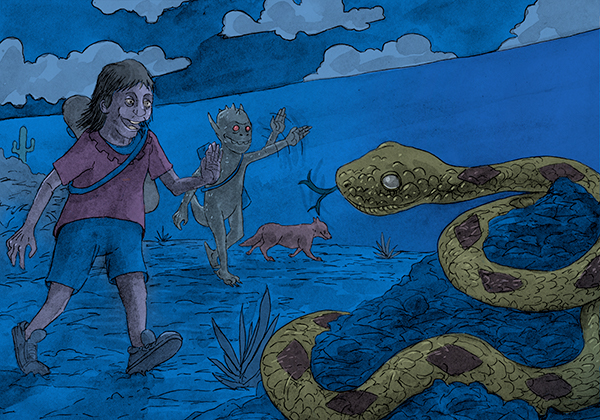Aldama creates complex Latinx representation for kids in The Adventures of Chupacabra Charlie


Distinguished University Professor Frederick Aldama’s abuela used to tell him stories when he was a child about how the chupacabra would get their chickens in the night. The chupacabra was a scary, hairless, fanged creature — “almost like one of those hairless cats, but bigger,” Aldama said — lurking in the dark and ready to jump out at unsuspecting children.
The chupacabra is a mythical creature popular among Latinx communities, especially in the American Southwest and Puerto Rico. It is rumored to attack animals and suck their blood (in Spanish, “chupar” means “to suck” and “cabra” means “goat”). But the creature’s malevolent reputation is getting a makeover in Aldama’s debut children’s book, The Adventures of Chupacabra Charlie, to be published by The Ohio State University Press in June.
In Aldama’s book, Charlie, a chupacabra, is a vegetarian who doesn’t have fangs. He lives in an unnamed Mexican bordertown with his parents in a society where chupacabras are marginalized. All he wants is to make a friend and go on an adventure beyond “The Wall” separating his home from “el otro lado” ("the other side"), or an unnamed United States.
“Chupacabra Charlie is a great instance of putting a children's book out there that is focused on a Latinx and also super marginalized character, a chupacabra, who's literally considered to be a monster,” Aldama, a faculty member in the Departments of English and Spanish and Portuguese, said. “We’re humanizing him, showing the reader the complexity of his thinking and actions and the joy of his adventure.”
The parallels between the world in which Chupacabra Charlie lives and the ongoing immigration crisis at the U.S./Mexico border are intentional and often conspicuous; at one point, Charlie also encounters children being held in cages.
It's...really important to bring truth to our children and engage them in ways that will allow them to see things that are happening in the world," Aldama said. "Representations that are complex and that get things right can free and liberate the imagination and our actions in the world.”
However, Aldama isn’t worried about presenting kids with controversial topics. Instead, he hopes the story gives parents opportunities to talk with their children about both cultural myths like the chupacabra and current events like immigration. Children’s books in general, he said, can be a powerful way to encourage kids to think about such complex ethical issues. They can utilize both visuals and writing to engage children’s imagination and respect their rich thinking and emotional capacity.
“There's this idea that children are fragile and that they should be protected from what's going on in the world, and there's a certain truth to that,” Aldama said. “But it's also really important to bring truth to our children and engage them in ways that will allow them to see things that are happening in the world.”
The Adventures of Chupacabra Charlie, illustrated by Chris Escobar and created for kids ages 7-9, is Aldama’s first children’s book, but he sees it as an extension of his scholarly and theoretical work focused on Latinx representation and early cognitive development.

Charlie and new friend Lupe meet a snake and coyote along their journey to The Wall.
Providing that nuanced representation is personal for Aldama. He remembers taking his daughter to the library when she was little and not finding books that could speak in exciting ways about her cultural world. That experience has been a significant source of inspiration for creating Chupacabra Charlie.
Aldama doesn’t want to stop there. He’s also written a sequel, again illustrated by Escobar, called The Adventures of Cocoa la Cuca about a hybrid human/beastie girl who likes to wear a cape and luchador mask and has a big imagination. He intends to write several more to create a series set along the borderlands.
“When you consider that Latinx characters are only represented in less than 3% of all children's books, and even then we're mostly represented as background figures, something like Chupacabra Charlie becomes especially important,” Aldama said. “Representations that are complex and that get things right can free and liberate the imagination and our actions in the world.”
